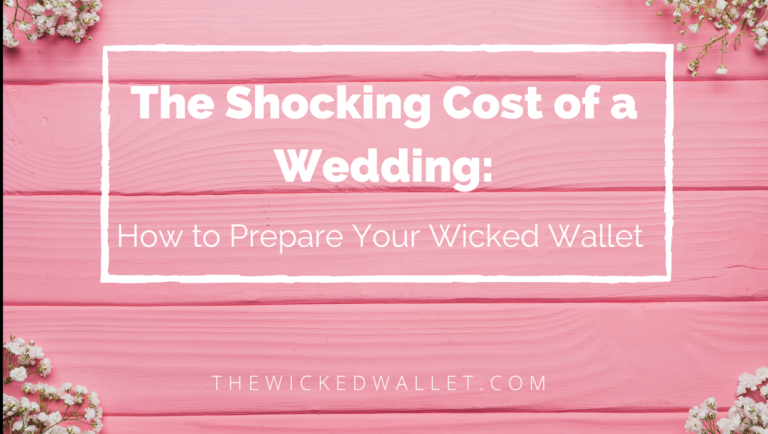I was recently reading the second edition of I Will Teach You To Be Rich by Ramit Sethi and found the section on wedding costs extremely eye opening. It was incredibly helpful due to the fact that we have had several readers reach out to us through multiple platforms on how to save for wedding costs.
It was clear that this topic needed to be covered and discussed. However, before you keep reading, I do have to warn you. The numbers that your about to see may be quite shocking, but with a plan in place anything is possible. So, let’s dive in.
What Is The Average Cost Of A Wedding?
According to The Knot, the average cost of a wedding in 2018 was $33,931 and that doesn’t include the glorified honeymoon. Now before you freak out and decide to never get married, remember that this is just an average. That means that plenty of people have spent well above and well below $33k.
The top 5 wedding expenses (on average) according to The Knot are:
- Wedding Venue – $15,439
- Engagement Ring – $5,680
- Reception Band – $4,247
- Photographer – $2,679
- Florist/Decor – $2,411
These 5 expenses alone are about 90% of the total average wedding costs. If you’re looking for areas to save in, then these would be your heavy hitters.
Alright, let’s talk about the average marriage age now that we’ve got some of the scary numbers out of the way.
According to the most recent statistics from the US Census Bureau the average marriage age in 2018 for men was 29 and 27 for woman.
Now, let’s imagine that you are planning to completely cover the cost of the wedding yourself. That is you and your partner are not receiving any money from family or friends.
The table below shows how much you personally would have to save per month in order to afford the cost of an average wedding.
| Males | ||
| Age | Years Until Marriage | Monthly Savings |
| 21 | 8 | $353.45 |
| 22 | 7 | $403.94 |
| 23 | 6 | $471.26 |
| 24 | 5 | $565.52 |
| 25 | 4 | $706.90 |
| 26 | 3 | $942.53 |
| 27 | 2 | $1,413.79 |
| 28 | 1 | $2,827.58 |
| 29 | 0 | — |
| Females | ||
| Age | Years Until Marriage | Monthly Savings |
| 21 | 6 | $471.26 |
| 22 | 5 | $565.52 |
| 23 | 4 | $706.90 |
| 24 | 3 | $942.53 |
| 25 | 2 | $1,413.79 |
| 26 | 1 | $2,827.58 |
| 27 | 0 | — |
From this table you can clearly see the benefit of saving earlier rather than later. It’s important to remember that this table is based on the average cost of a wedding and the average marriage age. You personally may have a wedding that costs well above or below $33,931. Heck you may not decide to get married until you’re 40. The point of this table is to show you that the earlier you start saving the better off you will be when/if the day comes.
How Should I Save For My Wedding?
Preemptively saving for a wedding, even if your not engaged or in a relationship, is a smart thing to do. If you foresee a wedding in your future then the time to start saving is now. The first step that you’ll want to take to prep for this life event is to create your wedding budget.
Creating Your Wedding Budget
Just because the average wedding costs over $33K doesn’t mean that’s what you have to spend. The amount you decide to spend on your wedding day is 100% your choice and there are a number of ways for setting your budget.
You can decide on a random budget and make your perfect wedding day fit within that constraint. Another option is to do some research and decide what your perfect wedding looks like. Then work backwards to figure the estimated cost and boom you have your wedding budget.
If you’re looking for a budget strategy that is simple and easy to use then definitely look into The Backwards Budget. This is our favorite method and it has helped us with so many of our financial goals, including saving 70% of our income.
After you’ve set a budget then the next step is to set up a sub savings account.
Sub Savings Account
A sub savings account is designed to be an offshoot of your normal savings account which is meant for a specific savings goal. In this case, it’s your wedding but you can also use a sub savings account for other big financial goals such as a house down payment.
When you set up your sub savings account with your bank you will be able to set up automatic monthly transfers. In no time at all you’ll have a solid chunk of change put away for that special day. Seeing this dedicated account grow will boost your motivation and take away some of the financial fears of marriage.
Closing Thoughts
Preparing for a wedding is more than just writing vows and saying I do. If you are planning on getting married one day and having a wedding then the time to start saving is now. As with all savings goals, the earlier you start the better off you’ll be.
Now that you know the shocking cost of a wedding it’s time to prepare. Create a budget, open a sub savings account, and start working towards your goal. If you have more questions and would like us to dive even deeper then please leave a comment below. 🙂
For more wicked reads check out these articles:



